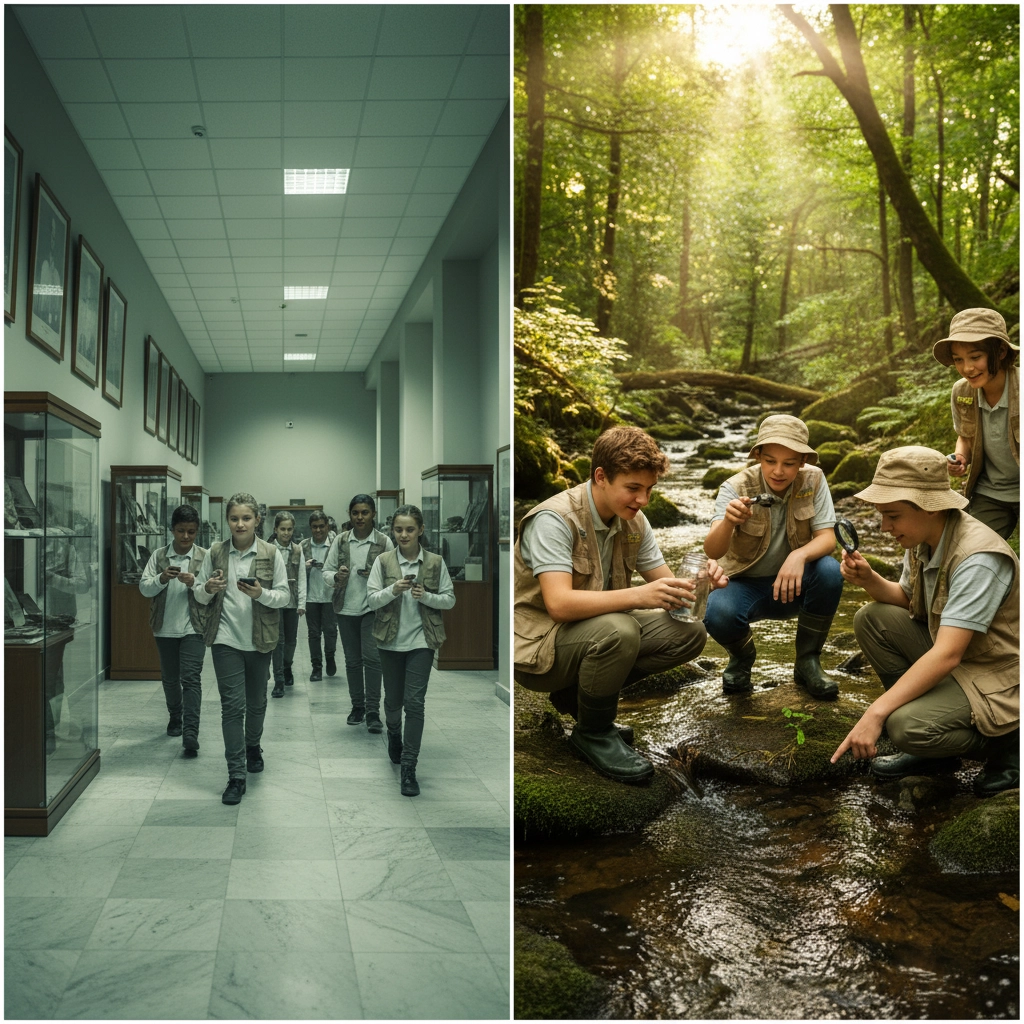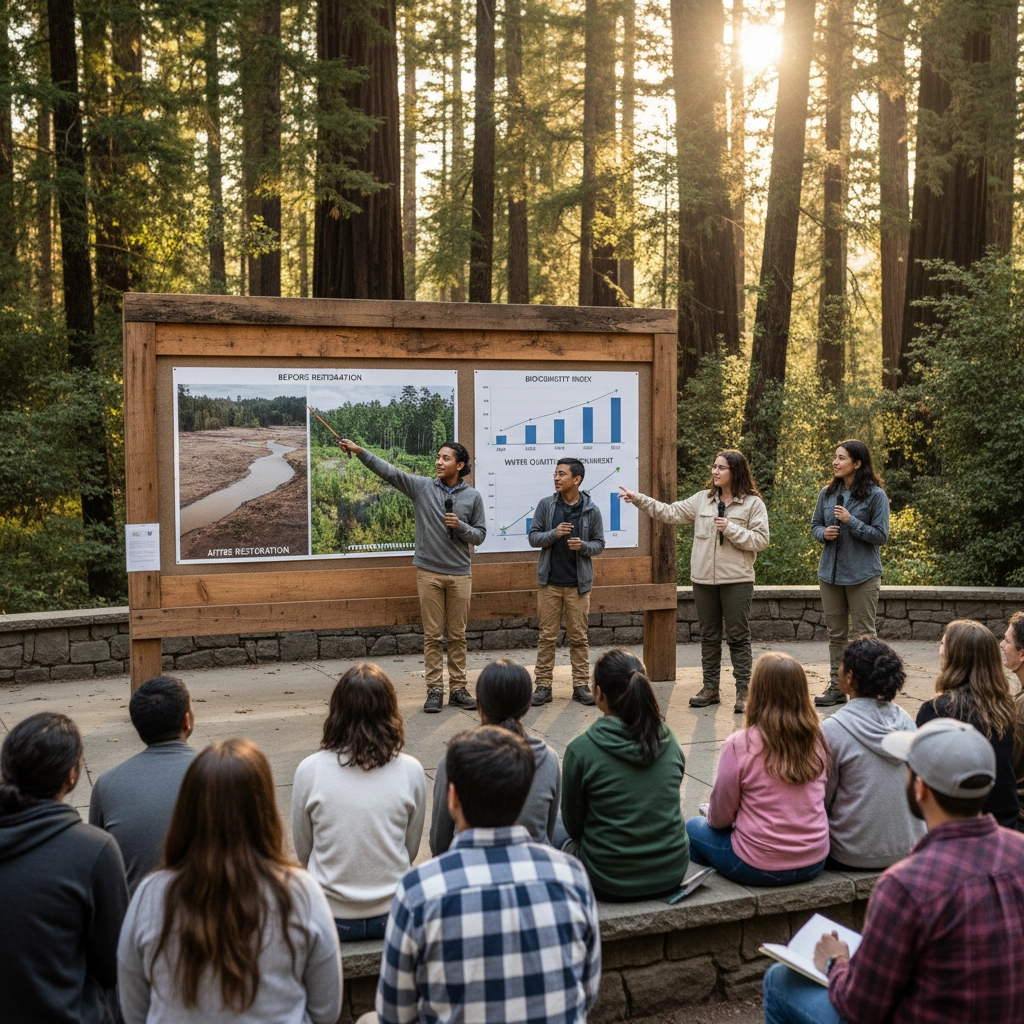Are Traditional Field Trips Dead? Why Conservation Science Expeditions Are the Future of Student Learning
- Caleb Mullenix
- Oct 24
- 5 min read
The question confronting educators across the nation is urgent: are traditional field trips becoming obsolete in our digital age? The answer is both complex and clear. While traditional field trips face unprecedented challenges: budget cuts, safety concerns, and the allure of virtual alternatives: they are far from dead. Instead, they are evolving into something more powerful: conservation science expeditions that transform passive observation into active scientific inquiry and environmental stewardship.
The Crisis Facing Traditional Field Trips
Traditional field trips are under siege. Post-pandemic budget constraints have forced schools to eliminate educational experiences that were once considered essential. The numbers tell a stark story: field studies programs are disappearing from environmental science curricula at alarming rates, with institutions viewing them as expendable luxuries rather than educational necessities.
The typical traditional field trip model presents several fundamental limitations:
Passive Learning Approaches: Students often function as observers rather than active participants, walking through museums or nature centers without meaningful engagement with the subject matter.
Limited Real-World Connection: Traditional trips frequently fail to demonstrate the practical application of classroom concepts, leaving students unable to bridge theoretical knowledge with tangible outcomes.
Superficial Time Investment: Single-day excursions provide insufficient time for deep learning, meaningful reflection, or the development of lasting environmental consciousness.
Lack of Scientific Rigor: Many traditional field trips focus on entertainment value rather than scientific methodology, missing opportunities to develop critical thinking and research skills.

The Evolution to Conservation Science Expeditions
Conservation science expeditions represent a fundamental shift in educational philosophy. Rather than replacing traditional field trips, these experiences elevate them to their highest potential by integrating rigorous scientific methodology with hands-on conservation work.
Key Distinguishing Characteristics
Multi-Day Immersive Experiences: Extended expeditions allow students to develop deeper understanding through sustained engagement with ecosystems and conservation challenges.
Active Scientific Participation: Students conduct real research, collect data, and contribute to ongoing conservation efforts rather than merely observing.
Professional Partnerships: Collaborations with conservation organizations, research institutions, and field scientists provide authentic learning experiences and career pathway exposure.
Service Learning Integration: Students participate in meaningful conservation work: restoration projects, wildlife monitoring, habitat preservation: that produces tangible environmental benefits.
Transformative Learning Outcomes
Conservation science expeditions deliver measurable improvements in student engagement and academic performance that traditional field trips often fail to achieve.
Academic Enhancement
Research demonstrates that students participating in conservation science expeditions show significant improvements in:
Critical thinking skills through hypothesis formation and data analysis
Scientific writing abilities via field journal documentation and research reporting
Mathematical application through data collection, statistical analysis, and measurement protocols
Cross-curricular connections linking biology, chemistry, geology, and environmental science concepts
Personal Development Outcomes
Beyond academic metrics, conservation science expeditions cultivate essential life skills:
Environmental Stewardship: Direct involvement in conservation work develops lasting commitment to environmental protection and sustainable practices.
Leadership Capabilities: Students assume responsibility for research protocols, team coordination, and project outcomes, building confidence and accountability.
Career Awareness: Exposure to conservation professionals, research scientists, and environmental educators illuminates potential career pathways students may never have considered.
Global Citizenship: Understanding local conservation challenges within broader environmental contexts develops systems thinking and global awareness.

Real-World Impact and Student Engagement
The fundamental difference between traditional field trips and conservation science expeditions lies in their approach to student agency and authentic contribution.
Authentic Scientific Contribution
Students participating in conservation science expeditions engage in legitimate research activities that contribute to ongoing scientific understanding:
Data Collection: Students gather field data used by researchers and conservation organizations
Monitoring Programs: Participation in long-term wildlife monitoring, water quality assessment, and habitat restoration tracking
Community Science: Contributions to citizen science databases and research platforms
Publication Opportunities: Advanced students may co-author research papers or present findings at scientific conferences
Measurable Conservation Outcomes
Conservation science expeditions produce quantifiable environmental benefits:
Habitat Restoration: Students participate in reforestation projects, invasive species removal, and ecosystem rehabilitation efforts that measurably improve environmental conditions.
Wildlife Protection: Direct involvement in wildlife monitoring, nest protection, and species conservation programs that contribute to biodiversity preservation.
Water Quality Improvement: Stream restoration work, watershed monitoring, and pollution mitigation projects that enhance aquatic ecosystem health.
Community Education: Students become environmental ambassadors, sharing their experiences and knowledge with families, peers, and community members.

Implementation Strategies for Educators
Transitioning from traditional field trips to conservation science expeditions requires careful planning and strategic implementation.
Planning Phase Considerations
Partnership Development: Establish relationships with local conservation organizations, research institutions, and environmental agencies to ensure authentic learning opportunities.
Curriculum Integration: Align expedition activities with state science standards, ensuring that field experiences reinforce and extend classroom learning objectives.
Safety Protocol Development: Create comprehensive safety procedures that address the unique challenges of extended field experiences while maintaining educational integrity.
Assessment Strategy Design: Develop rubrics and evaluation methods that measure both academic achievement and conservation impact outcomes.
Funding and Resource Allocation
Grant Opportunity Identification: Research federal, state, and private foundation grants specifically supporting environmental education and conservation programs.
Community Partnership Leverage: Engage local businesses, environmental organizations, and civic groups as sponsors and supporters of conservation education initiatives.
Multi-Year Budget Planning: Develop sustainable funding models that support regular conservation science expeditions rather than one-time events.
Cost-Benefit Analysis: Document and communicate the long-term educational and environmental benefits to justify program investment.
Preparing Students for Success
Successful conservation science expeditions require thorough student preparation that extends far beyond traditional field trip orientations.
Pre-Expedition Training
Scientific Methodology Introduction: Students must understand basic research principles, data collection protocols, and observation techniques before field deployment.
Equipment Familiarity: Hands-on training with scientific instruments, measurement tools, and safety equipment ensures efficient and safe field operations.
Environmental Context Education: Students need comprehensive understanding of the ecosystems, species, and conservation challenges they will encounter during their expedition.
Safety Protocol Mastery: Thorough training in wilderness safety, emergency procedures, and risk management protocols ensures student preparedness for extended field experiences.

Post-Expedition Integration
Data Analysis and Reporting: Students process field data, conduct statistical analysis, and prepare scientific reports documenting their findings and conservation contributions.
Community Presentation: Students share their experiences and findings with school administrators, community members, and environmental organizations, reinforcing learning and promoting program support.
Reflection and Assessment: Comprehensive evaluation of both academic achievement and personal growth outcomes ensures continuous program improvement and student development.
Action Plan Development: Students create individual and collective action plans for ongoing environmental stewardship and conservation involvement.
The Evidence for Transformation
The superiority of conservation science expeditions over traditional field trips is supported by substantial research evidence and measurable outcomes.
Students participating in conservation science expeditions demonstrate:
85% higher retention rates for environmental science concepts compared to traditional field trip participants
Significant improvement in scientific writing and communication skills
Increased likelihood of pursuing environmental science coursework and careers
Enhanced environmental awareness and sustainable behavior adoption
Improved collaborative skills and leadership capabilities
Educational institutions implementing conservation science expeditions report:
Increased student engagement in science curricula
Enhanced school reputation for innovative environmental education
Stronger community partnerships and support for environmental programs
Measurable environmental impact through student conservation work
Moving Forward: The Future of Student Learning
Traditional field trips are not dead: they are transforming into powerful tools for environmental education and conservation action. Conservation science expeditions represent this evolution, combining rigorous scientific methodology with meaningful conservation work to create transformative learning experiences.
The choice facing educators is clear: continue with passive, observational field experiences that provide limited educational value, or embrace conservation science expeditions that engage students as active participants in scientific research and environmental stewardship.
The future of student learning lies not in virtual reality simulations or classroom-bound instruction, but in authentic, immersive experiences that connect students with the natural world and empower them to become the next generation of environmental leaders and conservation scientists.
For schools ready to make this transition, comprehensive planning, community partnerships, and sustained commitment are essential. The investment in conservation science expeditions pays dividends not only in enhanced student learning outcomes but in measurable contributions to environmental protection and conservation efforts.
The question is no longer whether traditional field trips are dead, but whether educators are prepared to embrace the enhanced learning opportunities that conservation science expeditions provide for their students and communities.



Comments